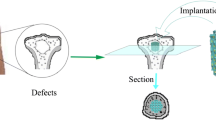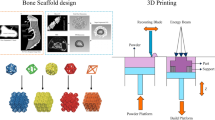Abstract
Advanced bone tissue engineering approaches rely on implanting synthetic grafts for the management of mid to large bone defects in order to overcome the common limitations associated with the use of transplant materials. Bioceramics are especially effective due to their versatile functional properties and processing methods. This chapter provides a picture of ceramic scaffolds for bone tissue engineering, focusing on additive manufacturing technologies and, specifically, the emerging method of digital light processing. The functional and structural complexity of natural bone makes the design of scaffolds a complex challenge as their chemical, structural and functional properties have to meet very specific requirements, e.g. adequate support properties, bone-bonding capability and a macro- and microporous structure to promote cell colonization and vascularization. Many fabrication techniques are currently available for the production of porous artificial biomaterials. Among them, the class of additive manufacturing technologies is one of the most promising methods for the development of mechanically competent and structurally highly defined scaffolds with tailored properties for bone tissue engineering applications.
Access this chapter
Tax calculation will be finalised at checkout
Purchases are for personal use only
Similar content being viewed by others
References
Lin K, Sheikh R, Romanazzo S, Roohani I (2019) 3D printing of bioceramic scaffolds-barriers to the clinical translation: from promise to reality, and future perspectives. Materials (Basel) 12(7):1–20
Gerhardt LC, Boccaccini AR (2010) Bioactive glass and glass-ceramic scaffolds for bone tissue engineering. Materials (Basel) 3(7):3867–3910
Dorozhkin S (2011) Medical application of calcium orthophosphate Bioceramics. Bio 1(1):1–51
Yeong W-Y et al (2004) Rapid prototyping in tissue engineering: challenges and potential. Trends Biotechnol 22(12):643–652
Rezwan K, Chen QZ, Blaker JJ, Boccaccini AR (2006) Biodegradable and bioactive porous polymer/inorganic composite scaffolds for bone tissue engineering. Biomaterials 27(18):3413–3431
Zhang L, Yang G, Johnson BN, Jia X (2019) Three-dimensional (3D) printed scaffold and material selection for bone repair. Acta Biomater 84:16–33
Mondal S, Pal U (2019) 3D hydroxyapatite scaffold for bone regeneration and local drug delivery applications. J. Drug Deliv. Sci. Technol. 53:1–11
Jazayeri HE et al (2018) The cross-disciplinary emergence of 3D printed bioceramic scaffolds in orthopedic bioengineering. Ceram Int 44(1):1–9
Baino F et al (2019) Processing methods for making porous bioactive glass-based scaffolds—A state-of-the-art review. Int J Appl Ceram Technol 16(5):1762–1796
ASTM International Standard Guide for Characterization of Ceramic and Mineral Based Scaffolds used for Tissue-Engineered Medical Products ( TEMPs ) and as Device for Surgical Implant Applications and ASTM Standard F2883 - 11, “Standard Guide for Characterization of Ceramic and Mineral Based Scaffolds used for Tissue-Engineered Medical Products (TEMPs) and as Device for Surgical Implant Applications,” ASTM B. Stand., no. January 2012, pp 1–7, 2011
Murphy CM, O’Brien FJ, Little DG, Schindeler A (2013) Cell-scaffold interactions in the bone tissue engineering triad. Eur. Cells Mater. 26:120–132
Amini AR, Laurencin CT, Nukavarapu SP (2012) Bone tissue engineering: Recent advances and challenges. Crit Rev Biomed Eng 40(5):363–408
Seol YJ, Park DY, Park JY, Kim SW, Park SJ, Cho DW (2013) A new method of fabricating robust freeform 3D ceramic scaffolds for bone tissue regeneration. Biotechnol Bioeng 110(5):1444–1455
Turnbull G et al (2018) 3D bioactive composite scaffolds for bone tissue engineering. Bioact. Mater 3(3):278–314
Babaie E, Bhaduri SB (2018) Fabrication aspects of porous biomaterials in orthopedic applications: a review. ACS Biomater Sci Eng 4(1):1–39
Doi K et al (2012) Development of implant/interconnected porous hydroxyapatite complex as new concept graft material. PLoS One 7(11) 1–10
Martinez-Marquez D, Mirnajafizadeh A, Carty CP, Stewart RA (2018) Application of quality by design for 3D printed bone prostheses and scaffolds 13(4)
Denry I, Kuhn LT (2016) Design and characterization of calcium phosphate ceramic scaffolds for bone tissue engineering. Dent Mater 32(1):43–53
Henkel J et al (2013) Bone Regeneration based on tissue engineering conceptions-A 21st century perspective. Bone Res. 1:216–248
Du X, Fu S, Zhu Y (2018) 3D printing of ceramic-based scaffolds for bone tissue engineering: an overview. J Mater Chem B 6(27):4397–4412
Chen QZ, Thouas GA (2011) Fabrication and characterization of sol-gel derived 45S5 Bioglass®-ceramic scaffolds. Acta Biomater 7(10):3616–3626
Boccaccini AR, Erol M, Stark WJ, Mohn D, Hong Z, Mano JF (2010) Polymer/bioactive glass nanocomposites for biomedical applications: a review. Compos Sci Technol 70:1764–1776
Szustakiewicz K et al (2019) The influence of hydroxyapatite content on properties of poly(L-lactide)/hydroxyapatite porous scaffolds obtained using thermal induced phase separation technique. Eur Polym J 113(January):313–320
Maquet V, Boccaccini AR, Pravata L, Notingher I, Jérôme R (2004) Porous poly(α-hydroxyacid)-bioglass composite scaffolds for bone tissue engineering. Biomaterials 25(18):4185–4194
Degli Esposti M, Chiellini F, Bondioli F, Morselli D, Fabbri P (2019) Highly porous PHB-based bioactive scaffolds for bone tissue engineering by in situ synthesis of hydroxyapatite. Mater Sci Eng C 100:286–296
Bretcanu O et al (2009) Electrospun nanofibrous biodegradable polyester coatings on Bioglass®-based glass-ceramics for tissue engineering. Mater Chem Phys 118(2–3):420–426
Hong Y et al (2010) Preparation, bioactivity, and drug release of hierarchical nanoporous bioactive glass ultrathin fibers. Adv Mater 22(6):754–758
Baino F, Novajra G, Vitale-Brovarone C (2015) Bioceramics and scaffolds: A winning combination for tissue engineering. Front Bioeng Biotechnol 3(December):1–17
Fu Q, Rahaman MN, Sonny Bal B, Brown RF, Day DE (2008) Mechanical and in vitro performance of 13–93 bioactive glass scaffolds prepared by a polymer foam replication technique. Acta Biomater 4(6):1854–1864
Chen QZ, Thompson ID, Boccaccini AR (2006) 45S5 Bioglass®-derived glass-ceramic scaffolds for bone tissue engineering. Biomaterials 27(11):2414–2425
Tripathi G, Basu B (2012) A porous hydroxyapatite scaffold for bone tissue engineering: Physico-mechanical and biological evaluations. Ceram Int 38(1):341–349
Gmeiner R et al (2015) Additive manufacturing of bioactive glasses and silicate bioceramics. J Ceram Sci Technol 6(2):75–86
Mancuso E, Alharbi N, Bretcanu O, Marshall M, Birch MA, McCaskie AW et al (2017) Three dimensional printing of porous load-bearing bioceramic scaffolds. Proc Inst Mech Eng H 231(6):575–585
Bose S, Vahabzadeh S, Bandyopadhyay A (2013) Bone tissue engineering using 3D printing. Mater Today 16(12):496–504
Ng AMH et al (2008) Differential osteogenic activity of osteoprogenitor cells on HA and TCP/HA scaffold of tissue engineered bone. J. Biomed Mater Res - Part A 85(2):301–312
Hutmacher DW, Sittinger M, Risbud MV (2004) Scaffold-based tissue engineering: Rationale for computer-aided design and solid free-form fabrication systems. Trends Biotechnol 22(7):354–362
Hollinger JO, Einhorn TA, Doll BA, Sfeir C (2017) Rapid prototyping technology and its application in bone tissue engineering. J Zhejiang Univ B (Biomedicine Biotechnol 18(4):303–315
Fantini M, Curto M, De Crescenzio F (2016) A method to design biomimetic scaffolds for bone tissue engineering based on Voronoi lattices. Virtual Phys. Prototyp. 11(2):77–90
Giannitelli SM, Accoto D, Trombetta M, Rainer A (2014) Current trends in the design of scaffolds for computer-aided tissue engineering. Acta Biomater 10(2):580–594
Schmidleithner C, Master thesis additive manufacturing of Tricalcium phosphate scaffolds for bone tissue engineering. Vienna University of Technology
Baino F, Barberi J, Fiume E, Orlygsson G, Massera J, Vern E (2019) Robocasting of Bioactive SiO2-P2O5-CaO-MgO-Na2O-K2O Glass Scaffolds. J Healthc Eng 2019
Moesen M, Craeghs T, Kruth JP, Schrooten J (2011) Robust beam compensation for laser-based additive manufacturing. CAD Comput. Aided Des 43(8):876–888
Bishop ES et al (2017) 3-D bioprinting technologies in tissue engineering and regenerative medicine: Current and future trends. Genes Dis. 4(4):185–195
Lantada AD, De Blas Romero A, Schwentenwein M, Jellinek C, Homa J (2016) Lithography-based ceramic manufacture (LCM) of auxetic structures: present capabilities and challenges. Smart Mater Struct 25(5)
Sun C, Fang N, Wu DM, Zhang X (2005) Projection micro-stereolithography using digital micro-mirror dynamic mask. Sens Actuat A Phys 121(1):113–120
Mao Y, Miyazaki T, Sakai K, Gong J, Zhu M, Ito H (2018) A 3D printable thermal energy storage crystalline gel using mask-projection stereolithography. Polymers (Basel) 10(10):1–14
Lee JH, Prud’homme RK, Aksay IA (2001) Cure depth in photopolymerization: experiments and theory. J Mater Res 16(12):3536–3544
Griffith ML , Halloran JW (1994) Ultraviolet curable ceramic suspensions for stereolithography of ceramics. Am Soc Mech Eng Prod Eng Div PED 68–2:529–534
Bae CJ, Ramachandran A, Chung K, Park S (2017) Ceramic stereolithography: additive manufacturing for 3D complex ceramic structures. J Korean Ceram Soc 54(6):470–477
de Blas Romero et al A (2017) Lithography-based additive manufacture of ceramic biodevices with design-controlled surface topographies. Int J Adv Manuf Technol 88(5–8):1547–1555
Gentry SP, Halloran JW (2013) Depth and width of cured lines in photopolymerizable ceramic suspensions. J Eur Ceram Soc 33(10):1981–1988
Hinczewski C, Corbel S, Chartier T (1998) Ceramic suspensions suitable for stereolithography. J Eur Ceram Soc 18(6):583–590
Bennett J (2017) Measuring UV curing parameters of commercial photopolymers used in additive manufacturing. Addit Manuf 18:203–212
Scalera F, Esposito Corcione C, Montagna F, Sannino A, Maffezzoli A (2014) Development and characterization of UV curable epoxy/hydroxyapatite suspensions for stereolithography applied to bone tissue engineering. Ceram Int 40(10): 15455–15462
Chartier T, Chaput C, Doreau F, Loiseau M (2002) Stereolithography of structural complex ceramic parts. J Mater Sci 37(15):3141–3147
Halloran JW et al (2011) Photopolymerization of powder suspensions for shaping ceramics. J Eur Ceram Soc 31(14):2613–2619
Mitteramskogler G et al (2014) Light curing strategies for lithography-based additive manufacturing of customized ceramics. Addit Manuf 1:110–118
Schwarzer E, Götz M, Markova D, Stafford D, Scheithauer U, Moritz T (2017) Lithography-based ceramic manufacturing (LCM)—Viscosity and cleaning as two quality influencing steps in the process chain of printing green parts. J Eur Ceram Soc 37(16):5329–5338
Schmidleithner C, Malferarri S, Palgrave R, Bomze D, Schwentenwein M, Kalaskar DM (2019) Application of high resolution DLP stereolithography for fabrication of tricalcium phosphate scaffolds for bone regeneration. Biomed Mater 14(4):1–11
Zeng Y et al (2018) 3D printing of hydroxyapatite scaffolds with good mechanical and biocompatible properties by digital light processing. J Mater Sci 53(9):6291–6301
Felzmann R et al (2012) Lithography-based additive manufacturing of cellular ceramic structures. Adv Eng Mater 14(12):1052–1058
Ko D, Gyak K, Kim D (2017) Emerging microreaction systems based on 3D printing techniques and aeparation technologies. J Flow Chem 7:72–81
Lu Y, Mapili G, Suhali G, Chen S, Roy K (2006) A digital micro-mirror device-based system for the microfabrication of complex, spatially patterned tissue engineering scaffolds. J Biomed Mater Res Part A 77(2):396–405
Han LH, Mapili G, Chen S, Roy K (2008) Projection microfabrication of three-dimensional scaffolds for tissue engineering. J Manuf Sci Eng Trans ASME 130(2):0210051–0210054
Potestio I (2019) Lithoz: How lithography-based ceramic AM is expanding the opportunities for technical ceramics. Powder Inject Mould Int 13(2):2–5
Mangano C, Mangano F, Gobbi L, Admakin O, Iketani S, Giuliani A (2019) Comparative study between laser light stereo-lithography 3D-printed and traditionally sintered biphasic calcium phosphate scaffolds by an integrated morphological, morphometric and mechanical analysis. Int J Mol Sci 20(13)
Tesavibul P et al (2015) Biocompatibility of hydroxyapatite scaffolds processed by lithography-based additive manufacturing. Biomed Mater Eng 26(1–2):31–38
Yao Y, Sha N, Zhao Z (2019) Highly concentrated hydroxyapatite suspension for DLP printing. IOP Conf Ser Mater Sci Eng 678(1):1–8
Tesavibul P et al (2012) Processing of 45S5 Bioglass® by lithography-based additive manufacturing. Mater Lett 74:81–84
Ghayor C, Weber FE (2018) Osteoconductive microarchitecture of bone substitutes for bone regeneration revisited. Front Physiol 9:1–10
Liu Z et al (2019) Additive manufacturing of hydroxyapatite bone scaffolds via digital light processing and in vitro compatibility. Ceram Int 45(8):11079–11086
Feng C et al (2020) Additive manufacturing of hydroxyapatite bioceramic scaffolds: Dispersion, digital light processing, sintering, mechanical properties, and biocompatibility. J Adv Ceram 9(3):360–373
Cao Y et al (2020) Fabrication and properties of zirconia/hydroxyapatite composite scaffold based on digital light processing. Ceram Int 46(2):2300–2308
Author information
Authors and Affiliations
Corresponding author
Editor information
Editors and Affiliations
Rights and permissions
Copyright information
© 2021 The Author(s), under exclusive license to Springer Nature Singapore Pte Ltd.
About this chapter
Cite this chapter
Baino, F., Fiume, E., Magnaterra, G., Verné, E. (2021). Additive Manufacturing of Bioceramic Scaffolds for Bone Tissue Regeneration with Emphasis on Stereolithographic Processing. In: Kumar, A., Voicu, S.I., Thakur, V.K. (eds) 3D printable Gel-inks for Tissue Engineering. Gels Horizons: From Science to Smart Materials. Springer, Singapore. https://doi.org/10.1007/978-981-16-4667-6_9
Download citation
DOI: https://doi.org/10.1007/978-981-16-4667-6_9
Published:
Publisher Name: Springer, Singapore
Print ISBN: 978-981-16-4666-9
Online ISBN: 978-981-16-4667-6
eBook Packages: Chemistry and Materials ScienceChemistry and Material Science (R0)




